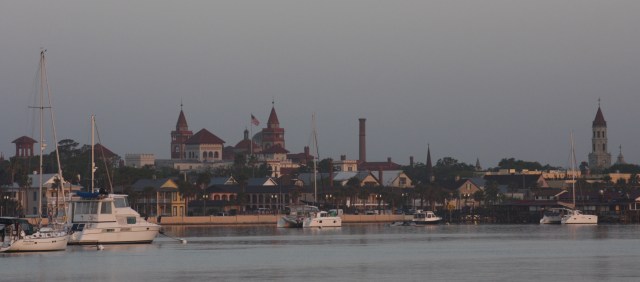Sleepy St. Augustine
(4/13/18) Most of St. Augustine was still sleeping when we pulled away from the River Edge Marina. It was a nice quiet morning to see this beautiful historic city.




The Bridge of Lions in St. Augustine has a strict opening policy. The bridge master will open the bridge on the hour and half hour except at 8 a.m., noon and 5 p.m. We were early for the 7:30 opening. Built in the 1920’s the bridge was to be the method of transportation for automobiles from St. Augustine to Anastasia Island where developer D.P. Davis had plans for a residential project to be named Davis Shores. The earlier bridge was wooden and could accommodate a trolley and had a moveable section for boat traffic. The construction by Davis was stopped due to the economy at the time but was resumed after WWII. The Davis Shores community is supposedly one of the nicest in the area.
The bascule bridge was designed by Henry Rodenbaugh, a bridge expert for Henry Flagler’s Florida East Coast Railway. The construction of the bridge came at the height of the Florida land boom of the 1920’s and was designed not just to carry cars to Anastasia Island but to be a work of art. The bridge which is listed on the National Register of Historic Places gets its name from the two Carrara marble lions which are copies of those found in the Loggia dei Lanzi in Florence Italy which were a gift to the city from Dr. Andrew Anderson who lived in the Markland House which is now owned by Flagler College. Dr. Anderson had two smaller lions sculpted for the Markland House.


The rising sun illuminated the cross above. This massive cross stands at the Mission Nombre de Dios and the Shrine of our Lady of La Leche. It is two hundred and eight feet tall, weights 70 tons and consists of 200 panels of stainless steel. The base of the Cross is covered with inscribed granite slabs which serve as memorials.

The masonry fort above is the oldest in the continental United States–it is the Castillo de San Marcos on the western shore fo the Matanzas Bay. Construction began in 1672 when Florida was part of the Spanish Empire. The fort is built using the bastion system of fortification which was popular during the time at which the cannon was a dominant feature of warfare. Many are star-shaped with bastions at the corners of the walls which eliminated protected blind spots along the walls. Another interesting feature of this fort is that it is constructed of a semi rare form of limestone called coquina. Only two forts in the world are built using coquina. Fort Matanzas, just 14 miles south, is the other using this material.
Hoping to spend some more time on the land in St. Augustine the next time we pass to explore its rich history.
Joy
2 thoughts on “Sleepy St. Augustine”
Comments are closed.
Beautiful! Love your posts….
I love quietly slipping through a city on the water in the early morning…glad you are reading.